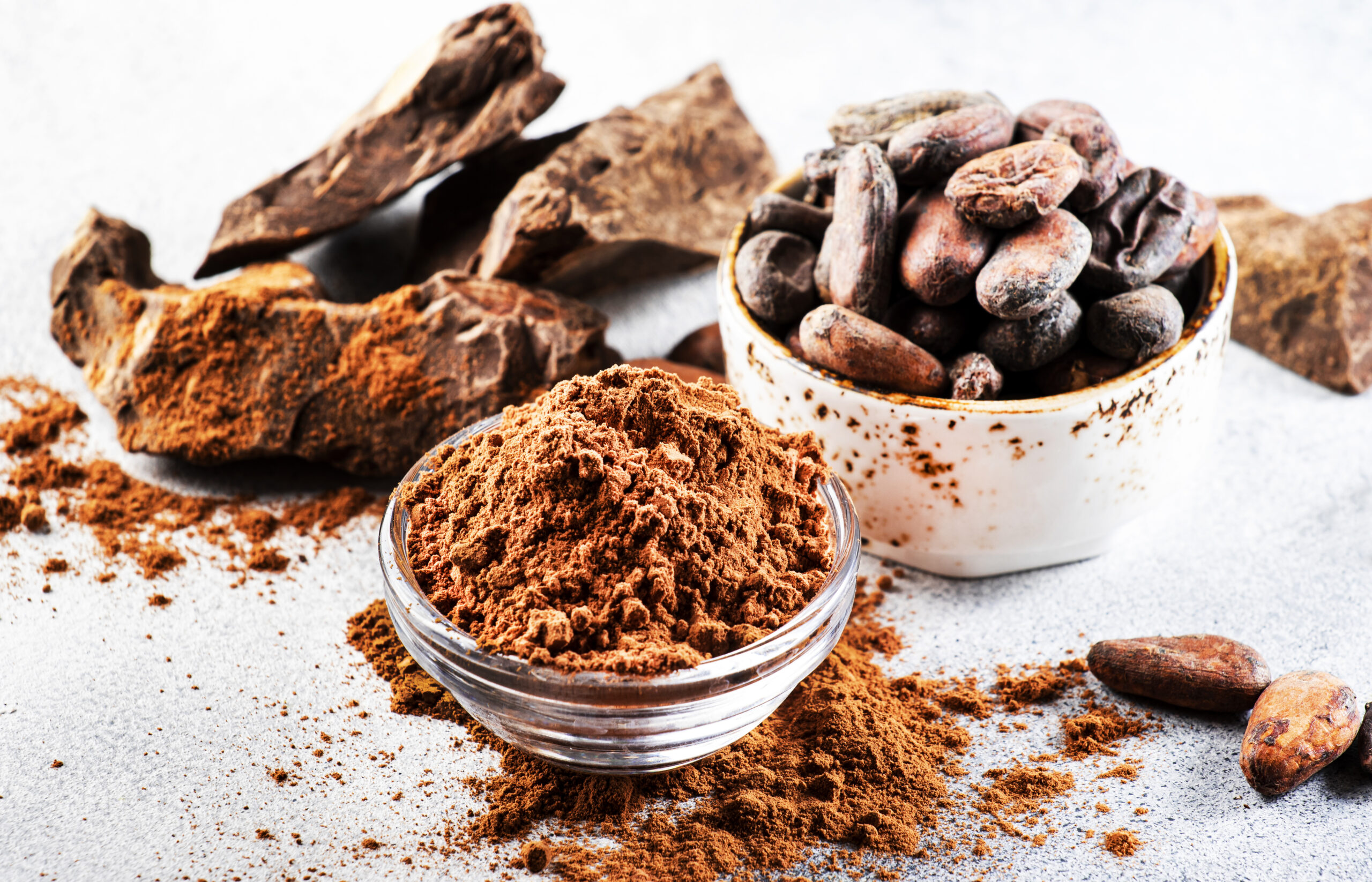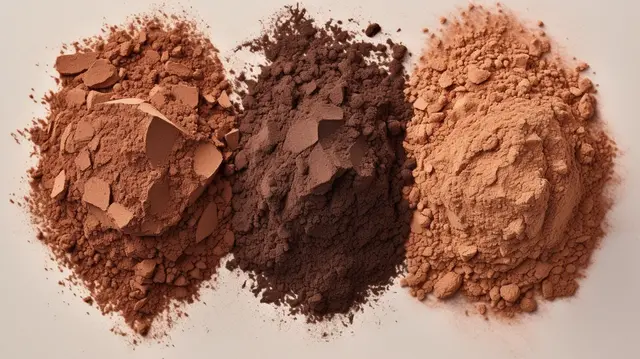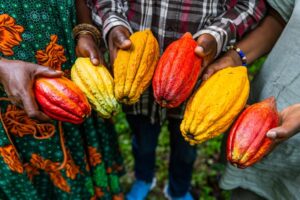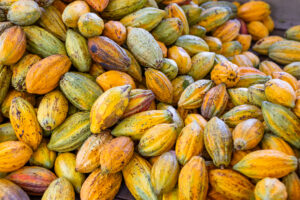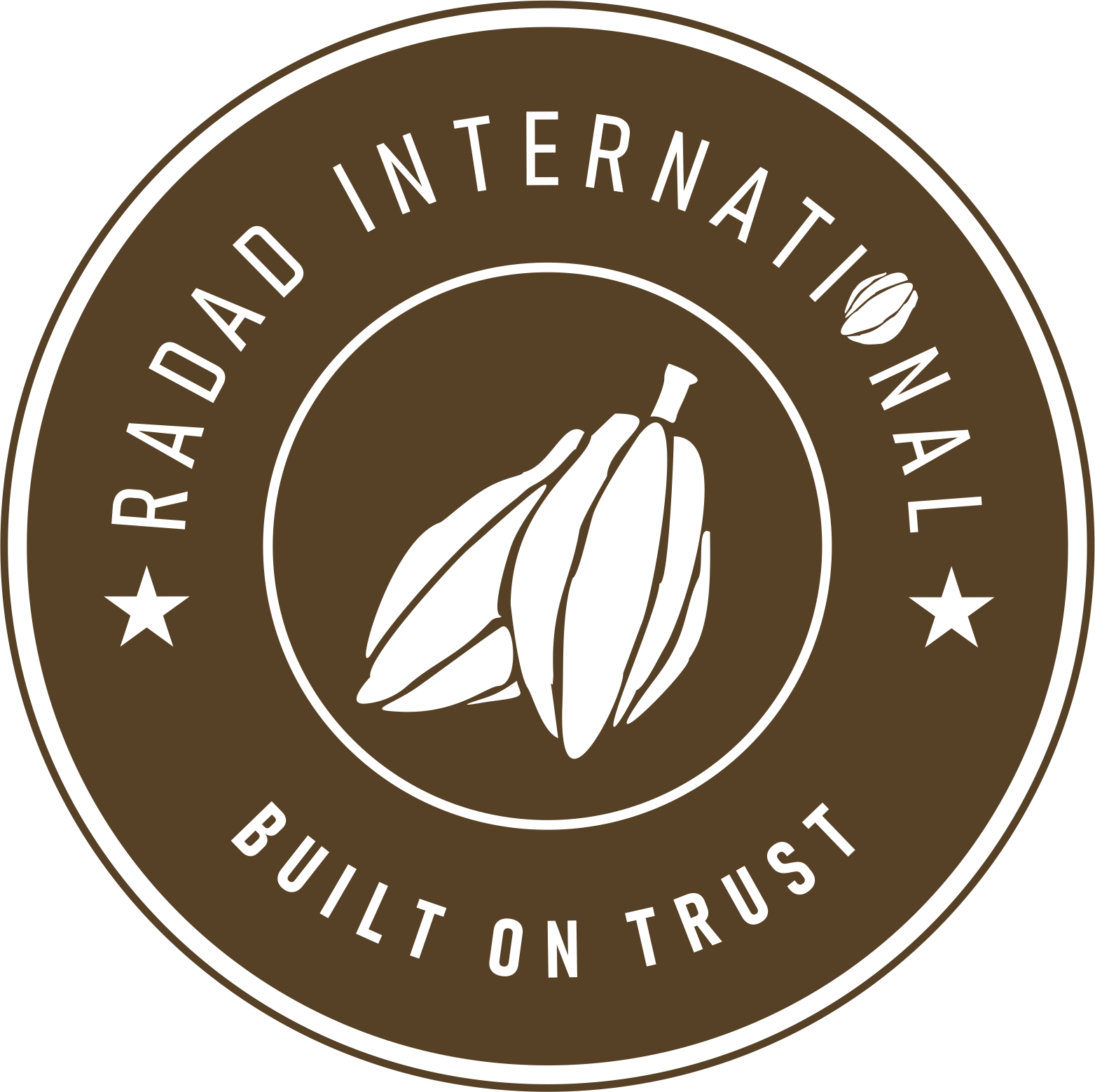What Exactly Is Alkalized Cocoa Powder?
Alkalized cocoa powder—often called Dutch-processed cocoa—is cocoa that has undergone an additional step beyond the basic processing of cocoa beans. After fermentation, drying, roasting, and pressing to separate cocoa butter from cocoa solids, the cocoa solids are treated with an alkaline solution (commonly potassium carbonate). This process:
-
- Neutralizes the natural acidity of cocoa
-
- Intensifies the color to a deep brown or reddish hue
-
- Mellow out the bitter, acidic notes, resulting in a smoother, milder flavor
The result is a premium ingredient favored by bakers, chocolatiers, ice-cream makers, and beverage developers.
Unlike its natural counterpart (natural cocoa powder), which retains its sharp, fruity acidity, this special form of cocoa undergoes a careful treatment with alkaline agents to smooth out bitterness, deepen color, and ensure consistent performance in every recipe.
Quick Glance: Natural vs. Alkalized
| Feature | Natural Cocoa | Alkalized Cocoa |
| Acidity (pH) | 5–6 | 7–8 |
| Flavor | Sharp, fruity | Smooth, mellow |
| Color | Light brown | Dark brown/reddish |
| Leavening reaction | Reacts with baking soda | Reacts with baking powder |
The Science Behind Alkalized Cocoa Powder
What Is Alkalization (Dutch Processing)?
Natural cocoa powder is produced by fermenting, drying, roasting, and pressing cocoa beans to remove most of the cocoa butter, leaving behind dry cocoa solids. These solids are naturally acidic (pH around 5). Alkalization involves adding an alkaline agent—usually potassium carbonate—to:
-
- Neutralize acidity (Raising pH from 5 to 7–8 for a milder taste)
-
- Improve Solubility in water and milk, making it easier to mix into batters and beverages
-
- Deepen color to rich chocolate brown or reddish-brown
-
- Smooth flavor by reducing sharp, tangy notes
Levels of Alkalization
Different producers aim for different flavor intensities and colors by adjusting alkaline concentration.
-
- Light Alkalization (pH ~7.0): Subtle color change, retains more cocoa’s natural brightness.
-
- Medium Alkalization (pH 7.2–7.6): Balanced taste and darker hue—common in bakeries.
-
- Heavy Alkalization (pH 7.8–8.0): Deepest color, most mellow flavor—favored by chocolatiers and dark chocolate producers.
Why is pH So Important?
-
- Baking Chemistry: Natural cocoa interacts with baking soda (alkaline) for leavening. Alkalized cocoa requires baking powder (acidic+alkaline) for proper rise.
-
- Flavor Profile: Higher pH reduces bitterness and highlights nutty and earthy notes.
-
- Shelf Stability: Neutral pH can improve color stability over storage.
In simple terms, manufacturers treat cocoa solids with an alkaline solution—usually potassium carbonate—to raise the pH level. This change transforms sharp, fruity undertones into a richer, rounder profile, making the powder ideal for any recipe where you want consistent, reliable cocoa taste and vibrant color.
A Quick Look at the Process
-
- Starting Point – Cocoa Beans: It all begins with fermented, dried cocoa beans. Quality starts here, with beans sourced from regions like West Africa (Nigeria, or South America.
-
- Roasting: Beans are roasted to bring out those rich, chocolatey aromas.
-
- Pressing: The roasted beans become nibs, and nibs turn into chocolate liquor. Pressing separates the cocoa butter from the solids.
-
- The Magic Step – Alkalization: The solids are bathed in an alkaline solution (often potassium carbonate). This neutralizes acidity and deepens the colour.
-
- Milling: Finally, the treated cocoa cake is ground into a fine powder—ready for packaging.
Here’s what makes alkalized cocoa powder an unsung hero:
-
- Balanced Flavor: By neutralizing excess acidity, the powder delivers a round, mellow chocolate taste that complements, rather than competes with, other ingredients in your recipe.
-
- Rich Color: The alkalization process intensifies natural pigments, providing a deep brown or reddish hue that holds up in baking, frosting, and drink mixes.
-
- Predictable Chemistry: With a standardized pH, this cocoa interacts seamlessly with baking powder, ensuring a reliable rise and texture without the unpredictable reactions you sometimes get with natural cocoa.
-
- Superior Solubility: Its improved ability to disperse in liquids makes it perfect for hot chocolates, mochas, and ready-to-drink mixes, delivering smoothness with every sip.
Understanding these benefits helps explain why professional bakers, chocolatiers, and beverage makers prefer Dutch-processed cocoa over natural alternatives.
Quality Checklist: Spotting Top-Tier Alkalized Cocoa Powder
When evaluating suppliers, look for:
-
- pH Value: Ideally between 7.2 and 8.0 (provided on CoA).
-
- Fat Content: 10–24%. Higher fat improves mouthfeel but may affect the dry mix texture.
-
- Moisture: <5% to prevent microbial growth and clumping.
-
- Ash: <8%. Low ash indicates purity.
-
- Particle Size: Fine, uniform particles ensure smooth batters and mixes.
-
- Color: Consistent, without light speckles.
-
- Aroma: Fresh, cocoa-forward scent—no mustiness.
-
- Taste: Mellow chocolate with no sour or soapy notes.
-
- Certifications: ISO 9001, HACCP, Halal, Kosher, and organic or Fairtrade, if required.
The table below summarises what you should watch out for, especially when you are going in for bulk orders
| Criterion | Ideal Range/Feature |
| pH Value | 7.2–8.0 |
| Fat Content | 10–24% |
| Moisture | <5% |
| Ash Content | <8% |
| Particle Size | Fine and uniform |
| Color | Consistent dark brown or reddish-brown |
| Aroma & Flavor | Fresh cocoa scent, no mustiness, smooth taste |
| Certifications | ISO 9001, HACCP, Halal, Kosher, Organic/Fairtrade |
Nutritional Breakdown of Dutch-Processed Cocoa (What’s Inside Your Alkalized Cocoa Powder?)
Beyond taste and appearance, alkalized cocoa powder demonstrates superior functional properties. Its improved solubility facilitates quick dispersion in liquids, making it the go-to choice for ready-to-drink hot chocolate mixes and gourmet beverages.
Its consistent pH level lends itself to reliable leavening when paired with baking powder, yielding cakes and confections with textural perfection. Moreover, the darker pigments developed through alkalization provide remarkable color stability, resisting fading over time and under varying temperature conditions.
Alkalization can reduce some antioxidants, but the powder remains nutrient-rich.
Here’s a detailed 100g breakdown:
| Nutrient | Amount | % DV* |
| Energy | 228 kcal | 11% |
| Protein | 20 g | 40% |
| Total Fat | 22 g | 34% |
| – Saturated | 13 g | 65% |
| Carbohydrate | 40 g | 13% |
| – Dietary Fiber | 33 g | 132% |
| – Sugars | 0 g | 0% |
| Iron | 13 mg | 72% |
| Magnesium | 499 mg | 125% |
| Phosphorus | 734 mg | 105% |
| Potassium | 1524 mg | 43% |
| Zinc | 6.8 mg | 62% |
| Flavonoids | High | — |
*Percent daily values based on a 2,000-calorie diet.
Health Note: Though alkalization can reduce up to 20% of flavonoids compared to natural cocoa, you still benefit from heart-healthy polyphenols—especially if you choose powders from high-cocoa varieties, and when balanced with the right ingredients in your recipes.
Usage Guidelines/Recipe Proportions (How to Use Alkalized Cocoa Powder)
Whether you’re measuring spoons for your favorite brownie recipe or scaling up for factory batches, getting your ratios right is key.
Home Baking (Per 200g Flour)
| Application | Flour Weight | Cocoa Amount | Leavening |
| Light Cake | 200 g | 30 g (3 tbsp) | 1 tsp baking powder |
| Rich Brownies | 200 g | 50 g (5 tbsp) | ¼ tsp salt |
| Chocolate Cookies | 250 g | 35 g (3.5 tbsp) | 1 tsp baking powder |
| Hot Chocolate Drink | — | 2 tsp (5 g) | — |
| Mocha Latte | — | 1 tsp (2.5 g) | — |
-
- Standard Cocoa Cake: 30–40g (3–4 tbsp) alkalized cocoa powder + 1 tsp baking powder.
-
- Rich Brownies: 50–60g (5–6 tbsp) alkalized cocoa + ¼ tsp salt. Reduce sugar slightly to let cocoa shine.
Beverages
-
- Hot Chocolate: 2 tsp (5g) cocoa + 1 tsp sugar per 200ml milk or water.
-
- Mocha: 1 tsp (2.5g) cocoa + 1 shot espresso + 150ml steamed milk.
Tips:
-
- Sifting: Always sift cocoa with dry ingredients to prevent lumps.
-
- Hydration: Let batter rest for 5 minutes to hydrate the cocoa fully.
-
- Temperature: Room-temperature ingredients help with proper dispersion.
Commercial/Industrial Formulations (Per 100kg Flour)
For large-scale production, percentages replace spoon measures:
-
- Cake Mixes: 8–10% cocoa powder by weight of flour. Baking powder at 2% of flour weight.
-
- Chocolate Beverage Mixes: 10–12% cocoa, 50–60% sugar, and 1–2% emulsifier (e.g., lecithin).
-
- Ice Cream Bases: 4–6% cocoa powder. Adjust stabilizers and fat content accordingly.
Pro Tip: Conduct pilot-scale trials to tweak moisture, emulsifiers, and mixing times for consistent results.
Always sift cocoa powder with dry ingredients to avoid lumps. Store opened bags in airtight containers and use within 6 months for peak freshness.
Storage & Shelf Life: Keeping It Fresh in Dubai
Dubai’s heat and humidity can be challenging.
-
- Temperature: Store at 18–25°C.
-
- Humidity: Below 55% RH.
-
- Packaging: Airtight, food-grade liners or sealed cartons.
-
- Shelf Life: 12–18 months. Check the CoA for exact best-before dates.
Avoid storing near strong odors—cocoa easily absorbs surrounding smells—and away from direct sunlight. Use older inventory first (FIFO approach).
Sourcing Alkalized Cocoa Powder in Dubai
Import Regulations & Documentation
-
- ESMA Compliance: UAE’s Emirates Authority for Standardization and Metrology sets food safety standards.
-
- Required Documents:
-
- Health Certificate
-
- Halal Certificate (for many UAE buyers)
-
- Certificate of Origin
-
- ISO/HACCP Certifications
-
- Required Documents:
Cost Factors
-
- Cocoa bean origin: West Africa vs. South America can affect prices.
-
- Processing Level: Higher pH powders may cost more due to more intensive processing.
-
- Packaging: Custom-printed bags or FIBCs add to unit cost.
-
- Volume Discounts: Bulk alkalized cocoa powder Dubai orders yield better rates since discounts are applied.
Logistics & Warehousing
-
- Free Zone Benefits: Lower or zero customs duties for approved zones.
-
- Warehouse Options: Climate-controlled vs. standard dry storage.
-
- Inland Transportation: From Jebel Ali Port to Dubai South or directly to your facility.
When it comes to alkalized cocoa suppliers in Dubai, Radad International consistently ranks high. Here’s why:
-
- Quality Assurance: In-house labs with rigorous testing protocols (pH, fat, moisture, microbial).
-
- Flexible Packaging: From 25kg cartons to 1,500kg FIBCs. Food-grade liners ensure product integrity.
-
- Ethical Sourcing: Partnerships with Fairtrade and Rainforest Alliance certified farms.
-
- Custom Services: Private labeling, tailored blends, and technical support for recipe development.
-
- Prompt Delivery: 3–5 day local delivery after order confirmation.
Packaging Options
| Format | Best For |
| 25kg Cartons | Bakeries & retail packs |
| 500kg Bulk Bags | Mid-sized manufacturers |
| 1–1.5MT FIBCs | Large-scale producers |
| Resealable Developer Kits | Artisan chocolatiers |
| Eco-Friendly Liners | Green-conscious brands |
Test packaging samples to ensure durability and freshness in your environment.
Packaging Innovations
-
- Craft-Style Developer Kits: Small-scale packs for artisan chocolatiers.
-
- Resealable Bags: For bakeries to maintain freshness.
-
- Bulk FIBCs: Efficient for large manufacturers.
-
- Eco-Friendly Options: Compostable liners and recycled cartons.
Consider asking suppliers for samples of packaging to test in your storage conditions.
Regulatory & Certification Essentials
-
- Food Safety: ISO 22000, HACCP
-
- Quality: ISO 9001
-
- Halal: Mandatory for Muslim consumers
-
- Kosher: Important for export markets
-
- Organic & Fairtrade: Growing demand among premium brands
Always verify certificates for authenticity and expiration dates.
Sustainability & Ethical Sourcing
Consumers in the UAE increasingly demand ethically sourced ingredients. Look for suppliers who offer:
-
- Traceability: From bean to powder, with batch records.
-
- Fairtrade: Ensures farmers receive fair wages.
-
- Organic: No synthetic pesticides or fertilizers.
-
- Environmental Initiatives: Reduced water usage, waste recycling.
Radad International’s sustainability reports detail carbon footprint reduction and community support programs in cocoa-growing regions.
Quick Fixes: Troubleshooting Common Cocoa Powder Issues
| Issue | Cause | Solution |
| Clumping in Powder | High humidity | Use desiccants; transfer to airtight container |
| Off-Flavour | Poor storage or old stock | Check production dates; smell/taste test batches before ordering |
| Inconsistent Color | Variable alkalization | Request batch almanac; test multiple lots |
| Poor Solubility | Large particle size | Sift powder; use emulsifiers (e.g., lecithin) |
Emerging Trends in the Cocoa & Chocolate Industry
-
Single-Origin Alkalized Cocoa: Customers want terroir-driven flavours—look for suppliers offering origin-specific powders.
-
Functional Cocoa Blends: Added vitamins, adaptogens, or protein blends.
-
Plant-Based Chocolates: Vegan-friendly formulations leading to increased demand for dairy-free cocoa mixes.
-
Interactive Experiences: Chocolate bars with QR codes linking to origin stories and tasting notes.
Where to Source the Best Alkalized Cocoa Powder in Dubai
Why Dubai?
-
Global Imports: Cocoa from West Africa, South America, and beyond flows into Dubai’s ports.
-
Efficient Logistics: Free zones, streamlined customs, and rapid internal distribution.
-
Market Diversity: From boutique chocolatiers in Downtown to industrial food parks in Dubai South.
-
Bulk Alkalized Cocoa Powder Dubai: Flexible MOQ from 25kg cartons to 1.5MT FIBCs.
-
Dutch-Processed Cocoa UAE: Consistent pH, fat content, and color.
-
Wholesale Cocoa Powder UAE: Competitive pricing without compromising quality.
-
Alkalized Cocoa Distributors UAE: Reliable delivery across the Emirates.
-
Ethical Sourcing: Partnerships with Fairtrade certified farms.
How to Choose Your Supplier
-
Request Technical Data Sheets (TDS) and CoA
-
Conduct Sample Trials in Your Recipes
-
Compare MOQs and Packaging Options
-
Assess Lead Times and Logistics Support

